2025 Hyundai Ioniq 5 N First Drive Review: Sweet Little Lies
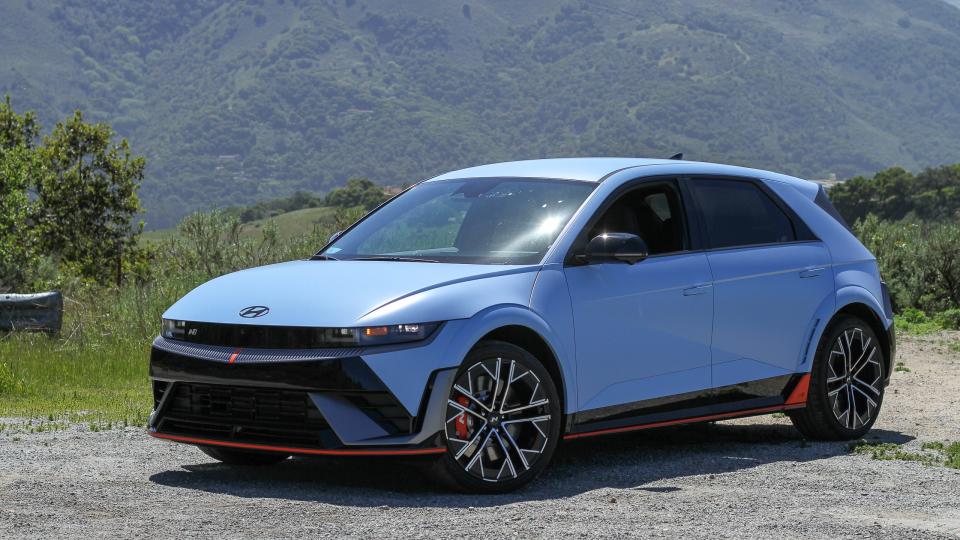
The 2025 Hyundai Ioniq 5 N might be bigger than the hatchback it appears to be in pictures, but this car is a riot. Prodigiously brisk, surprisingly involving, and—get this—wholly unique from every other EV out there, this is an electric car every driving enthusiast should pay attention to.
Hyundai calls this vehicle an SUV and, without a doubt, it is much larger than the Lancia Delta Integrale it vaguely resembles. But in this high-performance N trim, where the car is lowered by half an inch and the fenders are 50 mm wider (and body-colored), who are we kidding? This is a hot hatch.
The Basics
The new N's sport compact status is fronted by the presence of red and black trim pieces everywhere, 21-inch wheels, and enlarged grilles with active shutters (yes, electric motors need cooling too, especially given the sort of driving we're about to do). The rear reflectors look like checkered flags and the third brake light in the middle of the rear spoiler is triangular and very motorsport.





Inside, the steering wheel is new and plastered with a big, flat N logo to let you know you aren't driving just any ol' Hyundai. Bucket sport seats mounted 0.79 inches lower look appreciably cooler and hold you in place better than the chairs in the vanilla Ioniq and are partly trimmed in something Hyundai calls Eco Alcantara. Metal pedals have a checkered flag motif, too, and are joined by a pair of 12.3-inch screens rocking a whole slew of N-specific skins, gauges, and performance settings.
An electric motor at each axle draws power from a new 84-kWh battery that's more power-dense than the one in the regular Ioniq 5, spitting out a total of up to 641 horsepower and 568 lb-ft of torque.
Theatricality and Deception
One of the most common and frankly justified criticisms levied against electric cars is the notion that they all kind of drive the same. Smooth, planted, instant, mostly silent torque, and a slightly dull way of going about corners. With what Hyundai calls "N e-shift" turned on and some serious witchcraft in the handling department, the Ioniq 5 N does not have this problem.
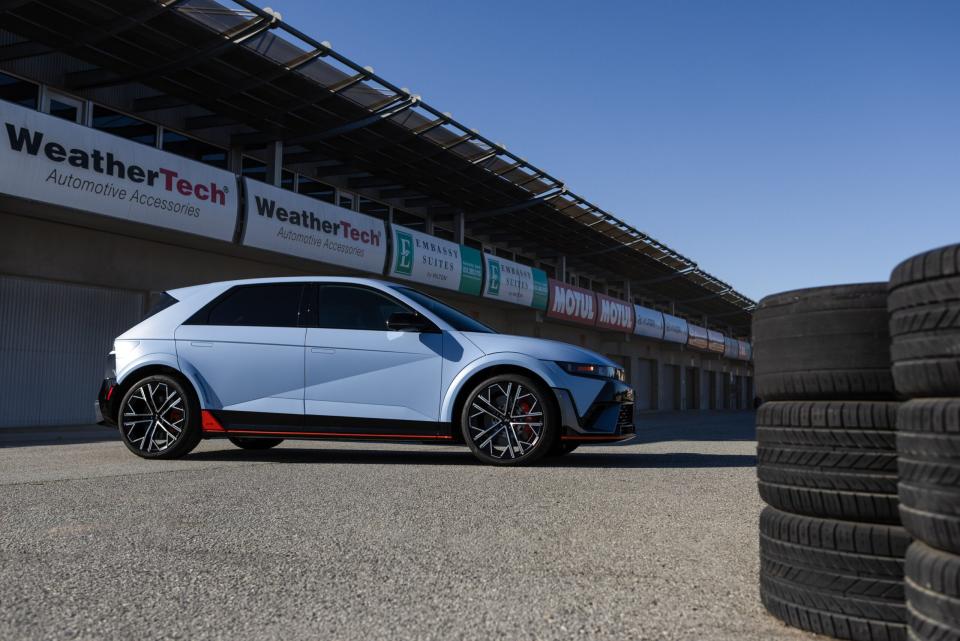
With the gas car-mimicking tech activated, this fully electric vehicle effectively becomes the world's fastest Veloster N. The bassy, buzzy, burbly noise being played through the speakers sounds just like that of Hyundai N's rowdily turbocharged four-cylinder. Torque and acceleration are doled out as if there's an eight-speed dual-clutch hiding underneath the center console—"manual" control can even be had via paddles and, just like a gas car, acceleration suffers if you aren't in the optimal "gear" or if you forget to shift up and run up against the "redline." The whole thing jolts on shifts like a dual-clutch Elantra N would. There's even a "tach" and an indicator in the instruments telling you what imaginary gear you're currently in.
All of this is, of course, a complete and utter fabrication. A farce; a mere video game masquerading as real motoring. The Ioniq 5 N hoodwinks, the Ioniq 5 N bamboozles, the Ioniq 5 N leads astray, the Ioniq 5 N runs amok—the Ioniq 5 N flat-out deceives. However, for all its digitized, electric lies, the Ioniq 5 N might just be the greatest video game on Earth because when the rubber meets the road, it is extremely, almost disturbingly convincing. Honestly, if someone put me in this car blind and told me to judge it based on driving experience alone, I probably wouldn't think it was electric at all.
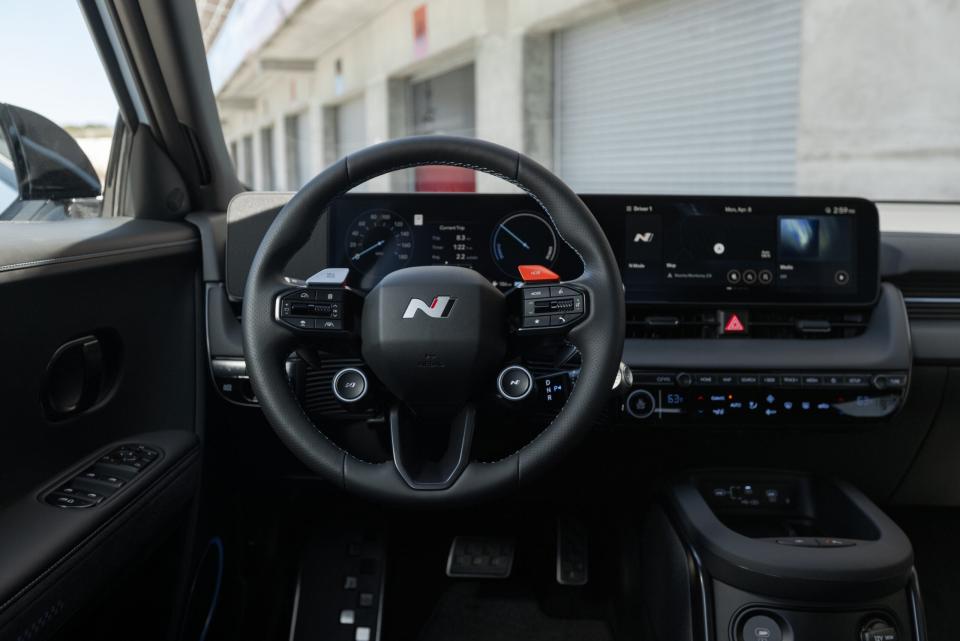
Speaking of flat-out, the Ioniq 5 N makes 601 hp as-is but the steering wheel button-activated N Grin Boost (something I will, for all our sakes, refer to as NGB from this point on) amps things up to the full 641 for 10 seconds at a time. With NGB on, zero to 60 mph takes precisely 3.25 seconds, which puts this car in the drag race crosshairs of the Porsche Taycan Turbo, an EV that starts at over $160,000 in Cross Turismo form. Given enough runway, the most powerful production Hyundai ever will top out at 162 mph. For what it's worth, that fancy Porsche is capped at 155 mph.
Remember that moment in Tokyo Drift when Han presents the protagonist with the red Evo and quips, "Whatchu think? Imma let you roll in a Hyundai?" Oh, how the tables have turned.
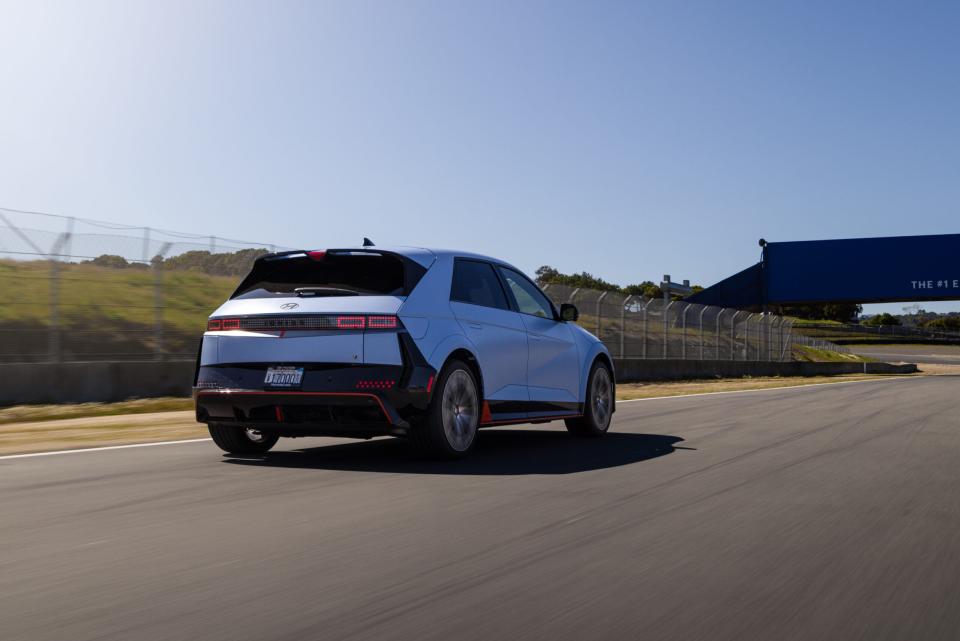
Brand New Tires
As previously established, though, straight-line speed and cool albeit synthetic noises aren't usually areas where EVs falter. Where they sometimes leave things to be desired is in the handling department and, thankfully, the Ioniq 5 N feels like a true N car through the hands as well.
The strengthened, quickened, and specially tuned steering rack is good—precise, well-ratioed, and weighted for both curvy roads and trackwork while adjustable, electronically controlled suspension possesses great range. Sport+ is probably too rough for the street but keeps things planted on track, Normal is daily-worthy soft, and the Sport in-between is just right for spirited canyon driving. The body-in-white gains 42 additional spot welds, the motor and battery mounts are reinforced, and there are 6.9 feet of extra structural adhesive over the regular Ioniq, resulting in a torsional strength increase of 11%.
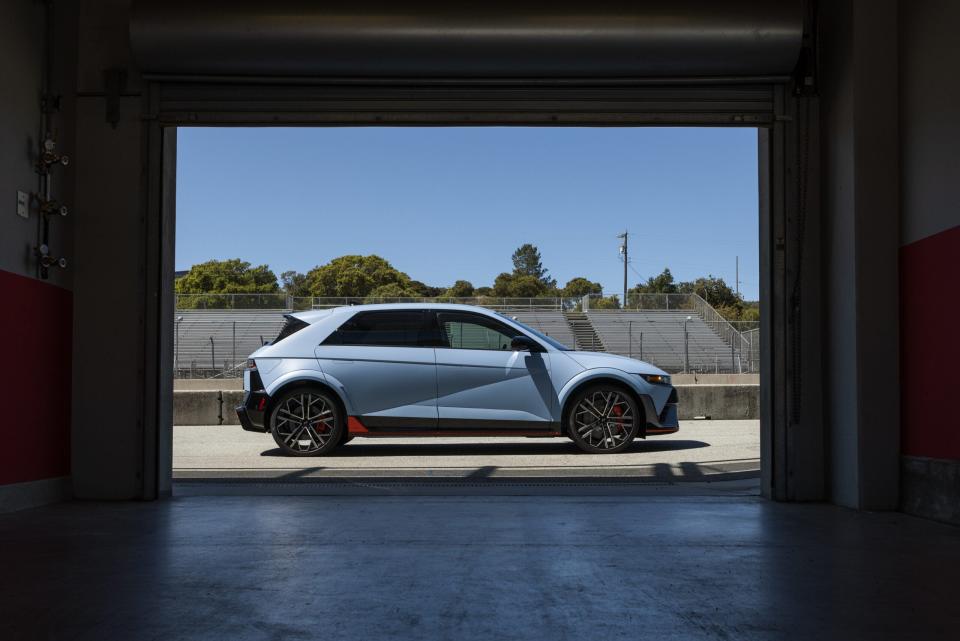
One EV aspect that's a bit harder to disguise is heft. Weighing in at 4,861 pounds (the battery alone accounts for 1,071 of those), the Ioniq 5 N is more than 1,700 pounds heavier than the gas-only Elantra N. Sticky Pirelli P Zero tires bespoke to this car and rally-derived Integrated Drive Axles front and rear mask that weight quite well, though.
Hucking it around Laguna Seca in manual mode with full sound on was a surprisingly visceral, thrilling experience honestly on par with, if not superior to, a whole lot of gas-powered performance cars I've driven. The ergonomics are great, and it carves up corners and nails apexes with shocking deft and ease, dispatching direction and elevation changes with reassuring stability—but not too much stability, y'know? It's all punctuated by immediate, seemingly endless wallops of power and speed on the straights that frankly feel unmatched with gas cars in this price range.
As an aside, you have not truly lived until you've floored 600 hp down the Corkscrew while "no body, no crime" by Taylor Swift blasts away in the background. But I ain't lettin' up until the day. I. Dieeeeeee.

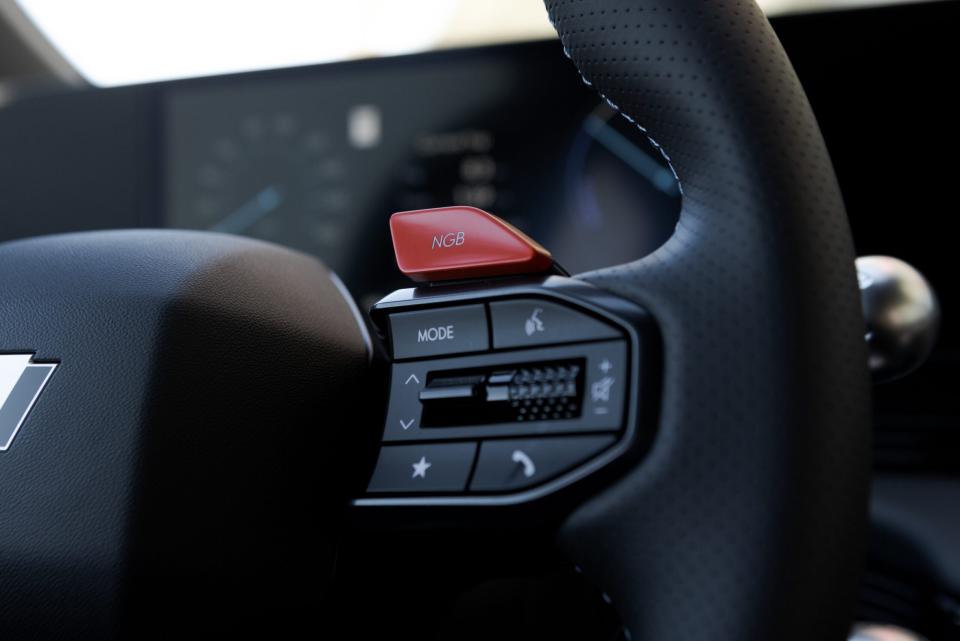
Speaking of not letting up, pressing the red NGB button for the first time was quite a rush, despite the gimmicky premise and even sillier name. Keeping with the video game theme, it puts the Ioniq 5 N in a Trevor-from-GTA-V-like Red Mist rage mode—the noise changes, the gauges change, and the urgency with which your head presses into the seat increases as all systems are primed for maximum attack.
Eleven driver-selectable, fully variable levels of front-rear torque output mean Ioniq 5 N can go from fully FWD to fully RWD (70 rear, 30 front is the default), while an electronic limited-slip differential and "N Drift Optimizer" function can simulate a clutch-kick to make smoky slides easier. Here's that in action:
This being the most powerful Hyundai to date, it also gets the most powerful braking system ever fitted to a Hyundai. Measuring 15.75 inches up front and 14.2 inches in the rear, the mechanical stoppers behind the wheels apparently play second fiddle to regen braking which does the heavy lifting. This meant consistently impressive slowing distances and minimal brake fade even after repeated, hard laps, a not-often-talked-about EV advantage over gas cars. If the Ioniq 5 N could improve in one area, though, it'd probably be the brake pedal which feels a tad spongier than I'd like the brake pedal of a hardcore track car like this to be.

 Yahoo Autos
Yahoo Autos 